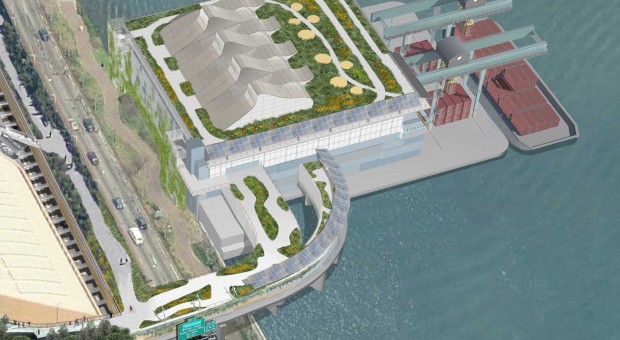- East 91st Street MTS Vision Study
East 91st Street MTS Vision Study

A New Vision for the East 91st Street Marine Transfer Station:
Addressing Safety, Pollution, Traffic, and Open Space Concerns
Michael Singer Studio, in collaboration with GNA and Sam Schwartz Engineering has been engaged by Asphalt Green to create a Vision Study for the East 91st Street Marine Transfer Station (MTS) in Manhattan. More people will be impacted by this MTS than any other MTS in the City, either because they live within close proximity to the MTS or because they are regular Asphalt Green users. Roughly 22,000 people live within a quarter-mile of the MTS; more than 5,700 of these residents are in nearby NYCHA housing. More than 1 million people, including over 34,000 children, use Asphalt Green regularly every year.
The Vision Study was created to address the serious traffic, safety, pollution, and open space concerns that have been raised by the community. If implemented, this Vision would provide significant community amenities and would reflect common ground between the City and the local community. Moreover, it could become a model of how urban infrastructure can co-exist with parks, public spaces, and dense residential neighborhoods. While these designs are preliminary and conceptual in nature, the goal of the Vision Study is to initiate a thorough discussion on innovative ways that the MTS can process waste with the least environmental impacts, while also providing new green space and an urban rooftop park to enable it to become a beneficial community public asset.
The Vision for the East 91st Street MTS is based on two main goals :
1. Leveraging this infrastructural investment to create a state-of-the-art civic space with public park land and recreational amenities on top of the MTS and its truck ramp.
2. Mitigating direct and indirect environmental impacts on Asphalt Green, adjacent parks, and the surrounding community through relocating the truck ramp and providing enhancements to the truck ramp, the MTS facility and facility operations.
One key aspect of the Vision entails constructing an enclosed structure from the ramp entrance all the way to the MTS. Wherever the truck ramp is located, this enclosure would mitigate local air and noise pollution, odors and visual impacts. The first 1000 feet of the truck ramp enclosure closest to the MTS would be ventilated like a tunnel, would exhaust at the top of the MTS, and would carry odor and air pollution away from Asphalt Green and the adjacent community. Portions of the ramp beyond the first 1000 feet of ramp from the MTS would be visually screened from the sides and top but would be passively ventilated. The ramp enclosure would have patterned linear cladding that is acoustically insulated to reduce localized noise pollution from trucks queuing or driving on the ramp. A Linear Park, similar to the successful High Line park in Chelsea, is proposed on top of the truck ramp enclosure. In addition to covering the truck ramp, this Linear Park provides safe access over the FDR Drive to the East River Esplanade and to the Green Roof Park proposed on top of the MTS facility. The Linear Park will have several pedestrian connection points in order to maximize public access from street level and the East River Esplanade. The existing ramp east of York Avenue on East 91st Street is proposed as a new park that would connect to the Linear Park on top of the truck ramp enclosure.
The major proposed change to the MTS building is lowering the pitch of the roof and constructing a Green Roof Park on the majority of the rooftop. This public park will transform the MTS from a single-use, utilitarian facility into the armature for a beautiful public waterfront space (just as nearby Riverbank State Park has done on top of the North River Sewage Treatment Plant). The green roof and the lower profile of the majority of the roof area will mitigate the visual impacts of the facility, especially when seen from nearby residential buildings. The expansive green roof will also provide additional mitigation for dampening noise from the facility, assist with facility stormwater management, and may be designed to assist with air quality and odor impacts. In conjunction with the MTS Green Roof, some architectural enhancements to the west, south and north façades of the MTS are proposed for view shed enhancements. These architectural enhancements include color and pattern variation and green walls (on the west) to add relief, soften and help humanize the scale of the imposing facility. Proposed improvements to the MTS facility also include numerous air pollution and odor mitigation strategies that are not currently planned for the MTS.
The Vision Study also examines cost savings (from the City’s own Office of Management and Budget) to offset the costs of these proposed enhancements. While the design in the Vision Study utilizes the same general footprint and structure of the MTS facility that is currently in construction, in an effort to control costs; there is also a proposal for making the MTS smaller at a cost savings of over $50 million, with no impacts on the day-to-day functionality of the facility.
Lead Designer: Michael Singer
Michael Singer Studio Project Team: Jason Bregman, Jonathan Fogelson, Cedrick Dawson, and Calen Colby, Marc Larochelle, Brian Beaulieu, and Aaron Sirois at Colby Co Engineering.
Asphalt Green Project Team: Carol Tweedy, Jeff Dorn, and Tom O’Connor
Project Team Management and Air Pollution Mitigation Strategies: Rich Kassel, Patrick Couch,
and Joe Annotti at Gladstein, Neandross & Associates (GNA)
Traffic Engineering and Ramp Strategies: Sam Schwartz, Janet Sharkey
and Jee Mee Kim at Sam Schwartz Engineering
Structural Engineering: Guy Nordenson, Lucile Walgenwitz, and Caryn Lee Farnum at Guy Nordenson Associates and Qi Ye, Courtney Clark, and James Quinn at Weidlinger Associates, Inc.

